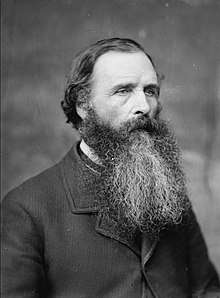Richard Owens (architect)
Richard Owens (1831 – 24 December 1891) was a Welsh architect, working mostly on urban housing in Liverpool, England and on the construction of chapels in Wales.
Richard Owens | |
|---|---|
 | |
| Born | 1831 |
| Died | 24 December 1891 (aged 59–60) |
| Known for | Architecture |
Notable work | Welsh Streets, Liverpool |
Background
Owens was born at Plas Bell, Y Ffôr, Pwllheli, Wales as the eldest son of Griffith Owens, a carpenter.[1]
After a period of primary education, he learned the carpenter's craft with his father and at the age of twenty, he went to Liverpool to work as a clerk and then as foreman to John Jones, a builder, in Everton. John Jones emigrated to the United States of America and Owens moved to Williams & Jones, Castle Street, Liverpool to a company that bought rural land around the old town of Liverpool to sell for housing developers. His main duties for Williams and Jones were to measure land and design plans.[2]
While working during the day, Owens also attended evening classes at the Institute of Engineering to learn more about architecture and design.[1]
Career
%2C_Liverpool_(print)_NLW3363689.jpg)
Owens began working as a freelance architect in 1862, among his first contracts being the building of a new place of worship for the Welsh Calvinistic Methodist congregation of Rose Place, Fitzclarence Street in Liverpool, where he was a member and which was the most expensive Welsh chapel (of similar historical value) to be built in the history of Welsh Nonconformity.[3] He subsequently designed over 250 other chapels for Welsh nonconformists,[1] of all denominations, throughout England and Wales, including the Baker Street chapels for the Congregationalists and the Calvinistic Methodist Tabernacle in Aberystwyth.[lower-alpha 1][4]
While working on the design of Mynydd Seion chapel, Abergele in 1867, he came into contact with the David Roberts & Co Company, Liverpool. The company were land surveyors and became dominant in Liverpool's housebuilding industry.[5] Through his collaboration with David Roberts, Owens designed over 10,000 terraced houses in the city of Liverpool, particularly those in the Toxteth area now commonly known as the Welsh Streets,[6] as many of the streets were named after Welsh towns and villages such as Voelas Street, Rhiwlas Street and Powis Street.[7] Ringo Starr was born in one of the Welsh Streets, in 9 Madryn Street and attended school in Pengwern Street. Owens also designed Roberts' coporate headquarters, Westminster Buildings, on Dale Street in the city.[5]
Owens was one of the most prolific architects of chapels in Wales[lower-alpha 2][9] and terraced houses in Liverpool. According to Dan Cruickshank, the historian, "Owens was so successful he could be responsible for (planning) more terraced houses in Victorian Britain than anyone else".[10]
Personal
In 1858, Owens married Margaret Roberts, daughter of Hugh Roberts in Llanfairfechan and together they had 5 daughters and one son. Owens was known for a "somewhat abrasive" personality; visiting the site of his Presbyterian church in Caernarfon he was so annoyed at what he considered sub-standard workmanship on the entrance gates that he ordered them to be pulled down, describing them in a letter to the foundry master as "most slovenly [and] of all the iron works that I ever had th[e] the worst specimen".[9]
He died at his home, 'Rhianfa' in Anfield Road, Liverpool at the age of 60 from gallstones and his remains were laid to rest at Anfield Cemetery.[1]
Footnotes
- As an example of Owens' industry, he designed four chapels, for four different denominations, in Aberystwyth alone: the English Baptist Chapel, the English Presbyterian Church, the Seion Independent Chapel and the Tabernacle Calvinistic Methodist Chapel.[4]
- As well as working for congregations of different faiths, Owens undertook work in a range of architectural styles; in Caernarfon, his Engedi Calvinistic Methodist Chapel on New Street is Italianate while his English Presbyterian Church in Castle Square is "uncompromisingly Gothic".[8]
References
- "Richard Owens – Architect, Architects of Greater Manchester". manchestervictorianarchitects.org.uk. The Victorian Society. Retrieved 16 April 2020.
- "Notitle – Y Cymro". Isaac Foulkes. 31 December 1891. Retrieved 31 May 2016.
- Page 4 No. 38 of Capel, Journal of the Chapels Heritage Society retrieved 31 May 2016
- Lloyd, Orbach & Scourfield 2006, pp. 405–406.
- Sharples 2004, p. 144.
- Toner, Christine (23 February 2018). "The Welsh Connection: How Wales has helped shape Liverpool". YM Liverpool.
- "Farewell Liverpool's Welsh streets". Wales Online. 31 March 2013. Retrieved 31 May 2016.
- Haslam, Orbach & Voelcker 2009, p. 287.
- "Richard Owens". www.welshchapels.org. Welsh Religious Buildings Trust. Retrieved 17 April 2020.
- BBC 4 Dan Cruickshank: At Home with the British Episode Two The Terrace, first broadcast 26 May 2016
Sources
- Haslam, Richard; Orbach, Julian; Voelcker, Adam (2009). Gwynedd. The Buildings of Wales. New Haven, US and London: Yale University Press. ISBN 978-0-300-14169-6.
- Lloyd, Thomas; Orbach, Julian; Scourfield, Robert (2006). Carmarthenshire and Ceredigion. The Buildings of Wales. New Haven, US and London: Yale University Press. ISBN 978-0-300-10179-9.
- Sharples, Joseph (2004). Liverpool. Pevsner Architectural Guides. New Haven, US and London: Yale University Press. ISBN 978-0-300-10258-1.
_(8287381582).jpg)